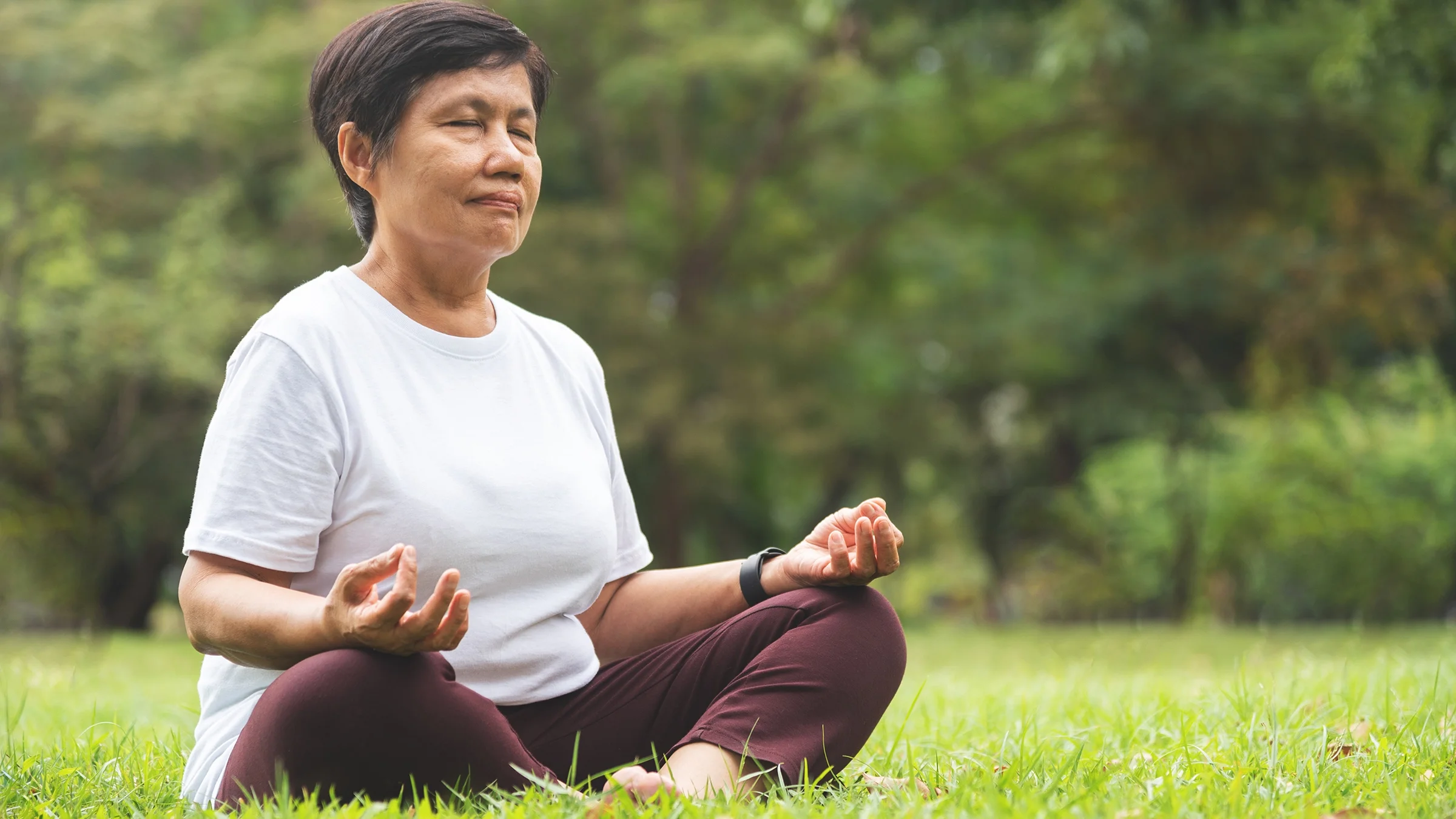Key takeaways:
Mindfulness is the practice of being aware of what you’re experiencing in a given moment without judging or trying to change it.
Research suggests mindfulness may help with pain management, physical illness, emotional wellness, stress, sleep, and more.
There are many ways to practice mindfulness. You can try sitting meditation, as well as working on being mindful throughout your day.
How often do you slow down and notice what’s going on around you? How about what’s happening in your body? Mindfulness is the practice of being aware of these things — of what you’re experiencing — in a given moment without judging or trying to change them. As a result, you can enjoy the moment more and worry less.
Practicing mindfulness continues to grow in popularity around the world, due to its many health and wellness benefits. Here’s what you need to know about this simple but powerful practice.
What is mindfulness meditation?
Mindfulness meditation is a broad term that’s used to describe similar practices. It can refer to both sitting meditation and everyday mindfulness.
Search and compare options
Sitting meditation is what it sounds like: sitting on a chair or cushion while practicing mindfulness.
Everyday mindfulness, on the other hand, can be practiced anywhere. For example, you might practice becoming more aware of your experiences when you work, do dishes, or play with your children.
How do you practice mindfulness?
You can practice mindfulness in any setting, whether you’re at home, at work, or in a meditation studio. Many people begin with structured meditations. Below are some common examples to get you started.
Mindful breathing
Mindful breathing is a core practice of mindful meditation. And variations of it are followed by people around the world.
Here are six basic steps for practicing mindful breathing:
Find a comfortable position. You might consider sitting in a chair with your back straight or on a pillow on the floor.
Begin by noticing your physical sensations. Feel your weight on the chair or the floor. Notice the feeling of your clothes on your skin.
Avoid judging or trying to change what you’re feeling. Try simply being curious about what’s happening.
Now, become aware of your breath. Don’t try to change the way you’re breathing — simply notice it. Feel the air going in through your nose and out your mouth.
Continue noticing your breath going in and out. Don’t try to force your attention. Your mind will likely wander, which is a normal part of practicing mindfulness. When you notice that happening, gently turn your attention back to your breath.
If you’re a beginner, continue this meditation for at least several seconds, up to a few minutes. You’ve just practiced mindfulness!
Read more like this
Explore these related articles, suggested for readers like you.
Over time, you can expand the length of your mindful breathing meditation.
Muscle relaxation
Muscle relaxation exercises involve becoming aware of the tension in your muscles. Depending on the exercise, you might purposefully tense up and then relax your muscles. In other cases, you may simply notice the tension, which helps you naturally relax.
Typically, you begin these exercises by focusing on one area of the body, such as the feet, and then moving up through each set of muscles. You might begin by noticing your toes, then your feet, ankles, and thighs. Move slowly and take several seconds with each area as you work all the way up to the top of your head.
Raisin meditation
Mindfully eating a raisin is a technique that’s often used in meditation classes. It involves focusing your attention on a raisin or other small piece of food and eating it slowly. You observe all of your senses — and the experience of holding, seeing, and eating the raisin.
Mindful eating programs sometimes use a similar approach. Begin by noticing the smell and look of your food. As you take a bite, chew slowly and notice the taste and other sensations before swallowing. Continue this throughout your meal.
Walking meditation
Walking meditation is much like it sounds. You observe the process of walking, becoming aware of each sensation you’re having. You can practice mindful walking for a few steps during your regular walk or even in your home.
Notice each foot as you raise it up and set it down. You may walk at a normal pace or significantly slow down your speed. Like with other types of mindfulness, you observe your experiences in the moment.
What does your body feel like as it moves? Do you feel weighed down or light? Become aware of the sensations of each step.
Loving-kindness meditation
Loving-kindness meditation focuses on acceptance. It involves sending positive thoughts to yourself and people you care about, as well as those you don’t know well. Through the process, you may also develop more compassion for and acceptance of yourself.
You can learn more about this practice and find a loving-kindness meditation script here.
Yoga
Yoga is an ancient practice that involves specific body postures and breathing techniques. It began in India, and is now practiced all over the world.
Research suggests that yoga has similar benefits to sitting meditation practices. One study compared the benefits of yoga and mindfulness meditation. It found that participants saw a decrease in stress and increase in self-compassion with both activities.
Tai chi
Tai chi combines a series of slow body movements with relaxation and breathing techniques. It is based on an ancient form of martial arts and is sometimes called “moving meditation.” Much like yoga and sitting meditation, it may help decrease stress and improve a person’s ability to adapt to new situations.
Mindfulness during everyday activities
Mindfulness extends beyond just structured meditation sessions. You can apply these practices to everyday life. You might mindfully eat your lunch or become more aware of your senses when you’re playing with a pet.
Another way to practice mindfulness in your daily life is during your interactions with other people. Rather than automatically responding to someone like you normally would, slow down and observe yourself in the moment. This may help you react in a more patient or helpful way.
How long do you need to be mindful each day to see some benefits?
There isn’t a standard length of time or frequency that’s considered best when practicing mindfulness. The results of research studies vary, so it’s hard to say what amount of time is best.
The mindfulness meditation program that’s been most studied is called mindfulness-based stress reduction (MBSR). In MBSR, participants attend weekly mindfulness classes for 8 weeks and are encouraged to practice at home for 30 to 45 minutes per day.
However, some experts believe that much shorter sessions (5 to 20 minutes) may be just as effective. And shorter but frequent sessions may be more realistic in day-to-day life.
To get into a habit of practicing mindfulness, consider starting with one or more 5-minute sessions per day. Pair the activity with another habit, such as brushing your teeth or taking your lunch break. Over time, notice how you feel and adjust your practice accordingly.
Resources to help you practice mindfulness
Are you interested in giving mindfulness a try, but don’t know where to start? There are many resources to choose from. Here’s a list of six to get you started.
1. Meditation classes or groups
You may be able to find meditation classes in your area. Some locations may offer weekly drop-in classes or organized groups held over a period of time. Search online or browse event calendars in your community. If you can’t find a local in-person class, search for live, online classes.
2. MBSR classes
MBSR courses are sometimes offered by local universities, wellness centers, and therapists. Search online for MBSR classes in your area. They may be offered at a cost or for free.
Palouse Mindfulness also offers a popular online version of MBSR, and it’s free. It includes a set of weekly videos and activities that you can work through on your own.
3. Meditation apps
There are many popular meditation apps you can access on your smartphone or other devices. There are both free and paid options.
Some apps offer guided exercises, while others can help you schedule regular meditation times. To find an app that fits your needs, search your app store for resources on meditation, relaxation, or mindfulness. You’ll be able to compare the features, reviews, and costs for each option.
4. Yoga or tai chi classes
You can often try practicing yoga or tai chi at a local community center or studio. Search online for classes in your area. You can also find online classes or videos to follow at home.
5. Social media and YouTube
Many online platforms, such as YouTube and Instagram, offer free videos of mindfulness meditations. This may be a good way to learn more about the practice as well as find guided exercises.
Look for activities that you are comfortable with and ones you think you can stick to.
6. Religious and spiritual groups
Many religious organizations, including churches and Buddhist centers, offer local mindfulness events. They may be included in broader spiritual practices, such as weekly services, or offered as stand-alone classes.
See what’s available in your area, or look for online options that are consistent with your spiritual beliefs.
How mindfulness can boost your mental health
Experts in many health fields, from psychiatry to oncology, recommend practicing mindfulness. Here are just some of the mental health benefits it can offer:
Lowered stress
Reduced rumination and overthinking
Better attention span and focus
Stronger working memory
Better ability to manage intense emotions
More flexibility in responding to what’s happening around you (cognitive flexibility)
Fewer distracting thoughts when working on a task
Ability to communicate emotions in your relationships
The bottom line
Mindfulness is the practice of slowing down and being more present and aware in the moment. This allows you to relax, decrease stress, and enjoy more of your experiences. You can practice mindfulness in a traditional sitting position, as well as in everyday life.
To get started, try taking a few minutes each day to pause and tune into what’s happening around you and how your body feels. If you’d like to grow your practice, look for mindfulness apps, online classes, or meditation groups in your area.

Why trust our experts?



References
American Psychological Association. (n.d.). Mindfulness.
Baylor University. (n.d.). Progressive muscle relaxation script.
Cui, L., et al. (2021). Tai chi chuan alters brain functional network plasticity and promotes cognitive flexibility. Frontiers in Psychology.
Davis, D. M., et al. (2012). What are the benefits of mindfulness?. CE Corner.
De Vibe, M., et al. (2010). Protocol: Mindfulness based stress reduction (MBSR) for improving health and social functioning in adults. Campbell Systematic Reviews.
Gorvine, M. M., et al. (2019). A naturalistic study of yoga, meditation, self-perceived stress, self-compassion, and mindfulness in college students. Health Psychology and Behavioral Medicine.
Hander, C. Y. (2017). Metta - Loving-kindness meditation. Commissioned Corps of the U.S. Public Health Service.
Mantzios, M., et al. (2019). A real-world application of short mindfulness-based practices: A review and reflection of the literature and a practical proposition for an effortless mindful lifestyle. American Journal of Lifestyle Medicine.
Mindfulness Training. (n.d.). Mindfully eating a raisin - Script.
Mirgain, S. (2016). A mindful breathing script. Veterans Health Administration.
National Center for Complementary and Integrative Health. (2021). Yoga: What you need to know.
Palouse Mindfulness. (n.d.). Homepage.
Thompson, B. L., et al. (2007). Everyday mindfulness and mindfulness meditation: Overlapping constructs or not?. Personality and Individual Differences.















